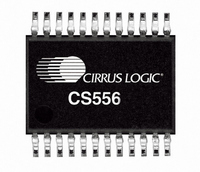CS5560-ISZR Cirrus Logic Inc, CS5560-ISZR Datasheet - Page 4

CS5560-ISZR
Manufacturer Part Number
CS5560-ISZR
Description
IC 50 DSDS 24-bit Mux DS ADC
Manufacturer
Cirrus Logic Inc
Specifications of CS5560-ISZR
Number Of Bits
24
Data Interface
Serial
Number Of Converters
1
Power Dissipation (max)
85mW
Voltage Supply Source
Dual ±
Operating Temperature
-40°C ~ 85°C
Mounting Type
Surface Mount
Package / Case
24-SSOP
Lead Free Status / RoHS Status
Lead free / RoHS Compliant
For Use With
598-1277 - KIT BOARD FOR CDB5560 ADC598-1273 - DEV BOARD FOR CS5560 W/MUX
Lead Free Status / RoHS Status
Lead free / RoHS Compliant, Lead free / RoHS Compliant
4
selected input's voltage level and this charge will be dumped into the next input’s source when that switch closes.
If an op-amp or high-impedance source is used for the input to the MUX, there could be an issue with settling when
this charge is transferred through the switch. One of the functions of the anti-alias capacitor on the input side of the
MUX in Figure 3 is to provide a reservoir of charge to the switch-channel capacitance. This is another reason why
the on resistance of the MUX should be as low as possible – so the channel capacitance can be charged quickly.
However, there is an inverse relationship between on resistance and channel capacitance because low on resis-
tance requires larger transistors and larger transistors result in higher channel capacitance. The following table
shows some examples of MUX devices along with their critical parameters. The devices grayed out are not recom-
mended due to the parameters indicated.
The third parameter to be considered when selecting a MUX is the switching speed. What needs to be considered
here is the total time from when the system selects another channel to when the conversion can begin. This includes
MUX turn-on time and analog circuitry settling time. For example, if it is desired to convert with the CS556x at its
maximum speed of 50 kSps (CONV held low), then from the time the RDY signal falls until the next conversion be-
gins is 10 MCLKs (at 16 MHz) or 625 nanoseconds. This means that the MUX channel must change as RDY falls
and its turn on time and all analog settling must occur in less than 625 nanoseconds.
250 nanoseconds to turn on, there is only 325 nanoseconds for the analog circuitry to settle. If more settling time
is required, the CONV pin timing can be delayed to slow down the conversion rate, allowing enough delay after the
MUX channel is changed to ensure complete settling.
The type of multiplexer selected will depend upon whether the converter is a single-ended-input or a differential-
input ADC. The advantage of using a differential ADC rather than one with a single-ended input is an improvement
1. Devices in gray are not recommended for this application due to the indicated parameters.
2. Parameters are typical values and are for comparative purposes only.
3. The manufacturer's data sheet should be referenced for min and max values
Notes:
ADG706
ADG707
ADG787
ADG884
DG406
DG407
DG408
DG409
HI-506
HI-507
HI-508
HI-509
ISL43L220
MAX306
MAX307
MAX4617
MAX4618
MAX4635
Number
Part
Poles
# of
1
2
2
2
1
2
1
2
1
2
1
2
2
1
2
1
2
2
Table 1: Critical Parameters of Typical Multiplexers
Inputs
# of
16
16
16
16
8
2
2
8
8
4
8
8
4
2
8
8
4
2
Speed ns
150/150
150/150
250/250
250/250
250/250
250/250
On/Off
134/98
134/98
130/55
130/55
50/14
50/14
53/21
7/4.5
7/4.5
12/5
12/5
22/6
On Res
Ohms
0.28
0.23
100
100
180
180
180
180
2.5
2.5
2.5
2.5
60
60
60
60
8
8
Cap pF
103
115
Off
13
13
16
10
10
10
10
6
6
3
3
8
8
5
5
9
On Cap
200
100
295
114
224
140
pF
40
57
37
25
62
40
27
22
70
32
21
32
±4.5 to ±20
±4.5 to ±20
1.8 to 5.5
1.8 to 5.5
1.8 to 5.5
1.8 to 5.5
±5 to ±20
±5 to ±20
±5 to ±20
±5 to ±20
1.1 to 4.5
1.8 to 5.5
Voltage
If a MUX requires
2 to 5.5
2 to 5.5
Supply
±15
±15
±15
±15
AN314REV1
AN314




















